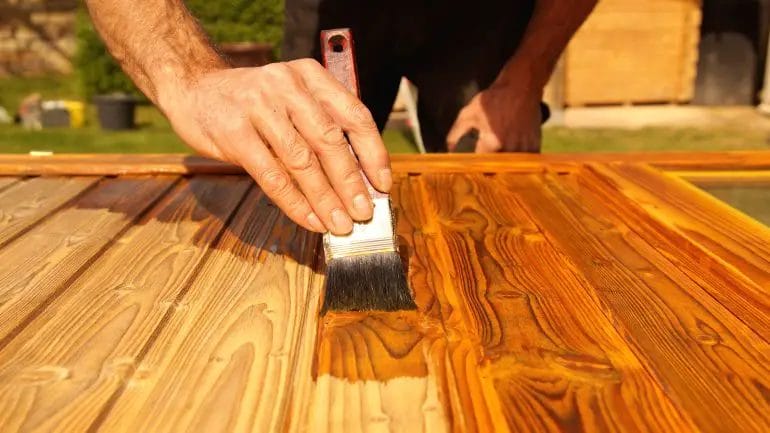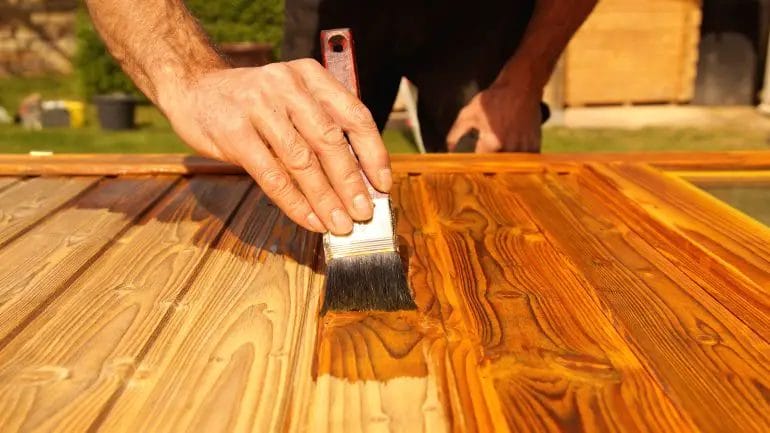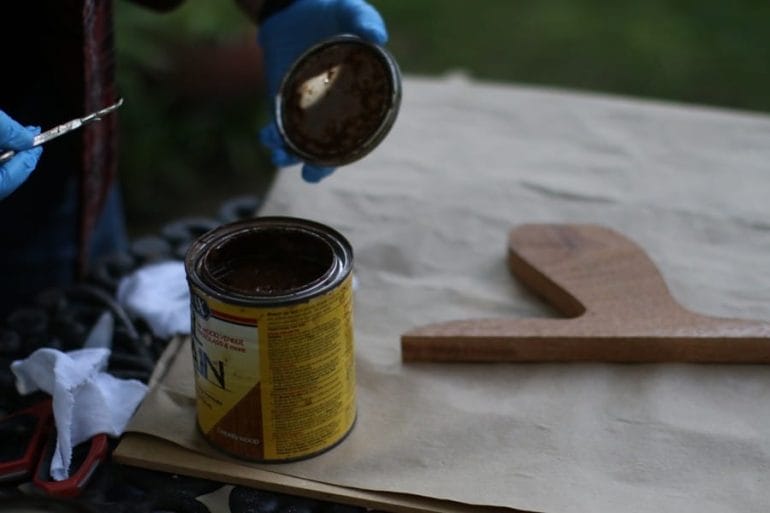Looking for the best way to dispose of wood stain? Properly disposing of wood stain is essential to protect the environment and comply with regulations. Here are some easy and eco-friendly methods to dispose of wood stain safely.
One option is to check with your local waste management facility for specific guidelines on how to dispose of wood stain. Some facilities may accept it as hazardous waste while others may have alternative disposal methods.

Another method is to use up the remaining wood stain on other projects or share it with friends or neighbors who might need it. This way, you reduce waste and ensure the product is put to good use.
If the wood stain is completely unused and in good condition, consider donating it to a local charity, school, or community center that offers woodworking programs. This ensures that the wood stain is utilized and benefits others.
Remember, never pour wood stain down the drain or throw it in the trash as it can contaminate water sources or harm wildlife. Always follow the proper disposal methods to protect the environment and promote sustainability.

Recycling Wood Stain Containers: Reduce, Reuse, Recycle!
Wood staining is a popular and effective way to enhance the beauty and longevity of wood products. However, when it comes to the disposal of wood stain containers, it’s important to consider the environmental impact. Fortunately, there are ways to reduce waste and maximize sustainability by recycling wood stain containers. In this section, we will explore the benefits of recycling, how to properly recycle wood stain containers, and some creative ways to reuse them.
The Benefits of Recycling Wood Stain Containers
Recycling wood stain containers offers numerous environmental benefits. By recycling these containers, we can:
- Reduce landfill waste: Wood stain containers, if not properly recycled, can contribute to the growing problem of landfill waste. Recycling helps to divert these containers from ending up in landfills, reducing the negative impact on the environment.
- Conserve resources: Recycling wood stain containers allows for the recovery of valuable materials such as plastic and metal. By reusing these materials, we can conserve natural resources and reduce the need for raw material extraction.
- Reduce energy consumption: Recycling wood stain containers requires less energy compared to producing new containers from virgin materials. This reduction in energy consumption helps to mitigate greenhouse gas emissions and combat climate change.
How to Properly Recycle Wood Stain Containers
Proper recycling of wood stain containers is essential to ensure that they can be effectively repurposed. Follow these steps to recycle your wood stain containers:
- Empty the container: Make sure that the wood stain container is completely empty before recycling. Check the label or instructions on the container for any specific guidelines on disposal or emptying.
- Rinse the container: Rinse out any residue from the container to prevent contamination. Use water and mild soap if necessary.
- Separate parts: If the wood stain container has multiple parts, such as a lid or label, separate them for proper recycling. Check with your local recycling facility to determine if these parts can be recycled together or if they need to be separated.
- Check local recycling guidelines: Different municipalities may have different recycling guidelines. Check with your local recycling center or visit their website to find out if wood stain containers are accepted and how they should be prepared for recycling.
- Recycle at the appropriate facility: Take your clean and separated wood stain containers to the designated recycling facility in your area. If curbside recycling is available, follow your local guidelines for recycling pickup.
Creative Ways to Reuse Wood Stain Containers
Instead of disposing of your wood stain containers, consider reusing them in creative and practical ways. Here are some ideas to give your wood stain containers a second life:
- Storage containers: Clean and repurpose wood stain containers as small storage containers for nails, screws, or other small items in your workshop or garage.
- Planters: With proper drainage holes, wood stain containers can be transformed into planters for small plants or herbs.
- Paintbrush holders: Use a clean wood stain container to hold your paintbrushes to keep them organized and easy to access during your next painting project.
- Arts and crafts: Get creative and use wood stain containers for various arts and crafts projects, such as storing paint, beads, or other small craft supplies.
In summary, recycling wood stain containers is a simple yet impactful way to reduce waste and contribute to a more sustainable future. By properly recycling these containers and exploring creative reuse options, we can minimize our environmental footprint and make a positive difference.

Safe Disposal Options for Unused Wood Stain
Wood stain is a popular product used to enhance the natural beauty of wood surfaces. Whether you’ve completed a renovation project or simply have leftover stain from a previous job, proper disposal of unused wood stain is essential for environmental safety. In this section, we will explore some safe disposal options that you can consider.
1. Donate or Share
If you have unused wood stain that is still in good condition, consider donating or sharing it with someone who may have a need for it. You can reach out to local community organizations, woodworking clubs, or even post on online platforms to find individuals who might be interested in taking it off your hands. This way, you not only ensure the product gets used, but you also reduce waste.
2. Store for Future Use
If you anticipate needing the wood stain in the future or have a small amount left that could be useful for touch-ups or smaller projects, storing it properly is a viable option. Ensure that the container is tightly sealed to prevent evaporation or leaks. Store the stain in a cool, dry place, away from direct sunlight, extreme temperatures, and potential sources of ignition. This way, the product will remain in good condition until you are ready to use it again.
3. Dispose of as Household Hazardous Waste
If you no longer have a need for the wood stain and it cannot be donated or stored, it is crucial to dispose of it as household hazardous waste. Check with your local waste management authority to find out about specific guidelines and regulations in your area. They may provide designated collection days or drop-off locations for hazardous materials like wood stain. It is important to follow their instructions carefully to ensure safe disposal.
4. Find a Recycling Program
In some cases, certain types of wood stain can be recycled. Check with local recycling centers or programs to see if they accept wood stain for recycling. Some programs may have specific requirements, such as only accepting water-based stains or certain container sizes. Make sure to follow their instructions and guidelines for proper recycling.
5. Consult a Professional
If you are unsure about how to dispose of your unused wood stain or have questions regarding its environmental impact, it is always a good idea to consult a professional. Contact your local environmental agency or waste management authority for advice or assistance. They have the expertise and knowledge to guide you through the proper disposal process and ensure compliance with local regulations.
Summary
Proper disposal of unused wood stain is crucial for environmental safety. Consider donating or sharing the stain if it is still usable. If storing for future use, ensure proper sealing and storage conditions. When disposing of the stain, follow local guidelines for household hazardous waste or explore recycling options. If in doubt, consult a professional to ensure compliance with regulations and minimize environmental impact.

Donating or Selling Unused Wood Stain: Sustainable Alternatives
Wood stain is a common product used by DIY enthusiasts, contractors, and homeowners alike to enhance the appearance of wood surfaces. However, it is not uncommon to end up with leftover stain after completing a project. Instead of letting these unused cans of stain go to waste, there are sustainable alternatives such as donating or selling them.
1. Donating Unused Wood Stain
One eco-friendly option for dealing with unused wood stain is to donate it to local organizations or individuals who may be in need of such products. Here are some potential recipients for your donation:
- Non-profit organizations: Contact local charities, community centers, or schools to see if they are interested in accepting your donation. These organizations may use the stain for their own projects or distribute it to individuals who need it.
- Community members: Consider reaching out to your neighbors, friends, or family members who might have a use for the stain. Many people enjoy taking on DIY projects and would appreciate receiving a free supply of wood stain.
- Online platforms: Utilize online platforms such as Freecycle, Craigslist, or local Facebook groups to offer your unused wood stain to people in your community. This can help you connect with individuals who are specifically looking for these types of products.
By donating your unused wood stain, you not only prevent it from going to waste but also contribute to a more sustainable community by promoting reuse and resource conservation.
2. Selling Unused Wood Stain
If you prefer to recoup some of the cost of your unused wood stain, selling it is another viable option. Here are a few ways to sell your unused stain:
- Online marketplaces: Platforms like eBay, Amazon, or specialized DIY forums offer opportunities to sell your unused wood stain to interested buyers. Create a detailed listing that includes information about the brand, color, quantity, and condition of the stain.
- Local classifieds: Place an ad in the classified section of your local newspaper or community bulletin board. This can attract potential buyers in your area who may be interested in purchasing your unused stain.
- Garage sales or flea markets: If you are planning to have a garage sale or participate in a flea market, include your unused wood stain as one of the items for sale. This can attract DIY enthusiasts or individuals looking for affordable home improvement supplies.
By selling your unused wood stain, you not only recover some of your investment but also provide others with an opportunity to purchase stain at a lower cost compared to buying new products.
Summary
Donating or selling unused wood stain can be a sustainable alternative to letting it go to waste. By donating, you can help organizations and individuals in need, while selling allows you to recoup some of the cost. Consider these options the next time you find yourself with leftover wood stain, and contribute to a more sustainable and resourceful community.
Regulations and Guidelines for Disposing of Wood Stain Safely
Wood stain is a popular choice for enhancing the beauty and durability of wooden furniture and surfaces. However, proper disposal of wood stain is crucial to protect the environment and prevent any potential harm to human health. In this section, we will discuss the regulations and guidelines for disposing of wood stain safely.
1. Check Local Regulations
Before disposing of any wood stain, it is important to check with your local regulations regarding hazardous waste disposal. Different areas may have specific guidelines and requirements for the disposal of hazardous materials, including wood stain.
2. Store and Handle Safely
Prior to disposal, it is essential to store and handle wood stain safely. Make sure to keep it in its original container with the lid tightly sealed to prevent any spills or leaks. Store the container in a cool, dry place away from heat sources or direct sunlight.
3. Use it Up
If you have leftover wood stain that is still usable, consider using it up instead of disposing of it. Look for additional projects or surfaces that could benefit from the application of the remaining stain. This not only reduces waste but also saves money.
4. Donate or Share
If you have excess wood stain that you no longer need, consider donating it to local community organizations, schools, or individuals who may find it useful. Sharing the stain with others is a great way to minimize waste and extend the lifespan of the product.
5. Dispose of Empty Containers Properly
Empty wood stain containers should be disposed of properly. Check with your local recycling or waste management center for specific instructions. Some areas may require containers to be triple rinsed or have the lids removed before recycling.
6. Hazardous Waste Collection Sites
In some cases, wood stain may be considered hazardous waste and should not be thrown away with regular trash. Contact your local hazardous waste collection facility or municipality to find out the proper procedures for disposing of wood stain. They may provide specific drop-off locations or scheduled collection events.
7. Alternative Disposal Methods
If no other options are available, you may need to consider alternative disposal methods such as taking the wood stain to a hazardous waste disposal facility. These facilities are equipped to handle and dispose of hazardous materials safely and legally.
8. Clean Up Spills Properly
In the event of a spill or accident involving wood stain, it is important to clean it up properly to minimize environmental impact. Use absorbent materials such as cat litter, sawdust, or sand to soak up the spill. Dispose of the contaminated materials as hazardous waste.
9. Dispose of Old or Expired Wood Stain
If you have old or expired wood stain that is no longer usable, it is crucial to dispose of it correctly. Contact your local hazardous waste facility for guidance on how to safely dispose of expired wood stain.
10. Follow Manufacturer’s Instructions
Always refer to the manufacturer’s instructions and recommendations for the safe disposal of wood stain. They may provide specific guidelines or additional precautions to ensure proper disposal.
In summary, disposing of wood stain safely is essential to protect the environment and human health. It is important to follow local regulations, store and handle the stain properly, use it up or share it if possible, and dispose of empty containers correctly. If necessary, contact your local hazardous waste facility for guidance on proper disposal methods. By following these regulations and guidelines, we can ensure the responsible and safe disposal of wood stain.
FAQs
1. How do I dispose of wood stain?
Wood stain is considered hazardous waste and should not be disposed of in regular trash. Contact your local waste management facility or check with your municipality for specific guidelines on how to properly dispose of wood stain. They may have designated drop-off sites or special instructions for disposal.
2. Can I pour wood stain down the drain?
No, pouring wood stain down the drain is not recommended. Wood stain contains chemicals that can be harmful to the environment and may clog your plumbing system. Always follow proper disposal guidelines provided by your local waste management facility.
3. Is it possible to reuse or recycle wood stain?
No, it is generally not possible to reuse or recycle wood stain. Once the stain has been applied to wood, it becomes chemically bonded and cannot be separated. It is best to use the entire can of stain for your project or give any excess stain to someone who can use it before it expires.
Conclusion:
In conclusion, knowing how to properly dispose of wood stain is crucial for a safe and eco-friendly environment. By following the regulations and guidelines set by your local waste management authorities, you can prevent environmental contamination and potential health hazards. Remember to never pour wood stain down the drain or dispose of it in the regular trash. Instead, consider recycling or donating unused stain to others who may need it. If you have no other option but to dispose of it, contact your local hazardous waste disposal facility for proper disposal methods. Let’s be responsible stewards of the environment and prioritize the proper disposal of wood stain.
